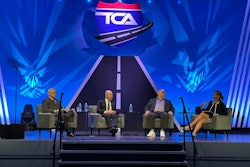Companies did better at recognizing their drivers in 2022 than in previous years.
That’s according to WorkHound’s Annual Trends Report that showed – for the first time ever – that praise was the leading category featuring significant positive feedback. The report, designed to help companies understand the industry from the drivers’ perspective and identify and address real-time issues before they become culture or retention problems, features positive and negative sentiment across 13 themes, including praise, people, equipment, communication, pay, logistics, uncategorized, miles, home time, training, safety, benefits and COVID-19. Of 32,600 anonymous drivers polled, 100% shared positive feedback in the praise category, which includes things like messages of gratitude.
“After discovering that praise was the number one theme, I talked to some other people on our team and went back and audited the results, and they stood true. It can be human nature to focus on the negatives while discounting the positives,” WorkHound Senior Customer Success Manager Jerome You said in a recent webinar that discussed data around driver job satisfaction and how to put it to good use. “Digging a little deeper and having conversations with some of these drivers – the source of this information – what we learned is that they weren't at all surprised by this. One driver told us it's basically about giving out what you want in return. Drivers are often very fair-minded, respectful people who are willing to praise the efforts in others because they want to be appreciated for their own contributions as well.”
In return, 42% of all feedback regarding the theme of people was positive, which You said ties into drivers being very willing to praise the people they work with – from driver managers to people in the shop working on their rigs.
Another standout statistic from the data that You found surprising was home time. The category had a higher positive percentage in 2022 compared to previous years at 31%.
That can be attributed to a benefits-plus strategy, said WorkHound CEO Max Farrell.
“We’re reaching a point within the industry, and really the modern workplace in North America, of where companies need to be offering benefits plus: health, dental, 401k. In this day and age, they're table stakes; people are expecting that the differentiating factor is going to be what else you bring to the table to help people be their full selves, not just in the walls of the workplace, but also outside of them,” Farrell said. “Looking at data like this, we can see that these benefits really do make a difference in the lives of drivers but also the staff, and those kinds of changes are the things that will drive both recruitment and retention.”
He said it could be things like mental health or family planning packages. You said some of the carriers he works with closely have things like employee-assistance programs, and these types of additional benefits help increase driver satisfaction.
[Related: Best Fleets To Drive For leaders discuss investments in people, technology]
But despite the positives in the report, overall driver satisfaction dropped slightly from an average of 6.70 in 2021 to 6.56 in 2022 (on a scale of one to 10). This is still higher than the 2020 score, which was an average of 6.39.
Much of the cause behind that drop, You said, is because of macroeconomic factors: ongoing supply chain issues, changes in customer spending habits, inflation, spot rates, etc. And the negative themes in the report mirror those conditions.
“All of this plays into trucking, so it stands to reason that a lot of this came up in the driver feedback and correlates with a lot of what carriers have seen as well,” You said. “It's a situation where carriers can be stuck between a rock and a hard place because of external factors. We understand how difficult it is for carriers to not only have to focus on solving or addressing the root of the issue but also dealing with the effects that trickle down to the drivers.”
The top negative themes of the report for 2022 were communication (63% negative feedback), pay (59% negative feedback) and logistics (58% negative feedback). You said this kind of feedback often pointed to complex pay, unclear training and other issues that made drivers’ jobs harder than they should be.
Farrell added that – combining the two themese – communication around pay is often an issue.
“Some drivers experience a lot of volatility: maybe a few hundred dollars one week to a few thousand the next, depending on the miles … That’s tough when you're not getting predictability with that sort of thing,” he said. “Not only that, the pay is often poorly communicated, and many drivers are rightfully confused about how and how much they are paid.”
Communication ranked sixth among negative comments in 2021. It jumped up to the top in 2022.
But communication can be a company’s saving grace, You said.
“Ultimately, we know there is not a silver bullet to address all the issues shown here,” he said. “It takes work and takes honesty; it takes steady progress to improve company culture and keep drivers engaged, especially with the market conditions and global climate like this. But we did pick up on three primary keys to success.”
First, he said, is a timely response to driver comments. Drivers can send anonymous comments and companies can respond all via WorkHound. Companies can choose to respond with a one-time message that alerts the driver that their comment has been seen and is being worked on or a reach-out request, which is a request to the driver to reveal their identity regarding their comments, which You said tends to yield the best results with the quickest resolution.
Either way, he recommends companies engage with the driver immediately even if they can’t solve the problem immediately.
“Responding right away shows that you want to try to help and that you are on their side,” he said. “In the absence of information, it's easy for people to create false, incorrect or incomplete narratives. We all know that drivers talk with each other; they have other outlets where they can share their opinions, and one of the most dangerous things is if they are not responded to and they look at WorkHound or they look at their company as bad communicators.”
The second key to success is empathy, he said.
“The workplace culture as we know it has evolved and will continue to evolve across all industries, and what it boils down to is most people just want to feel heard,” You said.
And, finally, is showing drivers their comments were heard by implementing change and communicating the changes made. That ultimately builds trust between the carrier and driver.
Farrell said this could be as simple as fixing a broken toilet or cleaning a dirty shower in the driver lounge.
“Sometimes it doesn't have to be solving these larger issues such as pay and logistics, which will always be present in the industry,” You added. “Our feedback provides a lot of so-called low hanging fruit, whether it be facilities issues or other issues that are relatively minor that can be addressed or at least discussed with the driver. That's why we think company culture should be a primary focus for employers in 2023 and beyond.”














